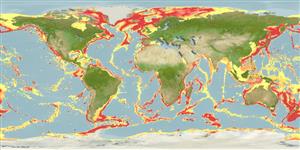Scyphozoa |
Coronatae |
Periphyllidae
Environment: milieu / climate zone / depth range / distribution range
Ecology
Pelagic; depth range 0 - 2900 m (Ref. 116114), usually 0 - 300 m (Ref. 121705). Tropical; 70°N - 78°S, 180°W - 180°E
Circumglobal.
Length at first maturity / Size / Weight / Age
Maturity: Lm ? range ? - ? cm Max length : 35.0 cm WD male/unsexed; (Ref. 121705)
Up to 20 cm wide; usually higher than wide, with a pointed or dome-shaped apex; gonads U-shaped; stomach and subumbrella purple or violet.
Found In deep waters (Ref. 116114). Symbiotic with amphipods, Hyperoche medusarum, Cyllopus magellanicus and juvenile Themisto guadichaudii (Ref. 3052), and has pycnogonids as an ectoparasite (Ref. 1943). Adults and juveniles of the pycnogonid Bathypallenopsis scoparia are found attached to this jellyfish (Ref. 121217). Exhibits vertical migration. Majority of the medusae moved from the deep basin to a zone below thermocline, a distance ranging from 100 to 400 m, at night. Move downward and disperse within water column below 200 to 350 m at dawn and during daylight hours, reside in narrow vertical intervals (about 60 m) in August and broader intervals (about 100 m) in December. Observed at water below thermocline at temperatures 6 to 8°C (Ref. 3051). Carcass and fresh samples used as bait of this species are scavenged by Myxine glutinosa, Munida tenuimana, Orchomenella obtusa, a decapod shrimp (Ref. 108800) and other unknown decapods (Ref. 108805).
Life cycle and mating behavior
Maturity | Reproduction | Spawning | Eggs | Fecundity | Larvae
Members of the class Scyphozoa are gonochoric. Life cycle: Egg is laid by the adult medusa which later develops into a free-living planula, then to a scyphistoma to a strobila, and lastly to a free-living young medusa.
Migotto, A.E., A.C. Marques, A.C. Morandini and F.L. da Silveira. 2002. (Ref. 813)
IUCN Red List Status (Ref. 130435)
CITES status (Ref. 108899)
Not Evaluated
Not Evaluated
Threat to humans
Human uses
| FishSource |
Tools
Internet sources
Estimates based on models
Preferred temperature
(Ref.
115969): 1.7 - 6.4, mean 3.4 (based on 3792 cells).
Vulnerability
Low vulnerability (10 of 100).
Price category
Unknown.
